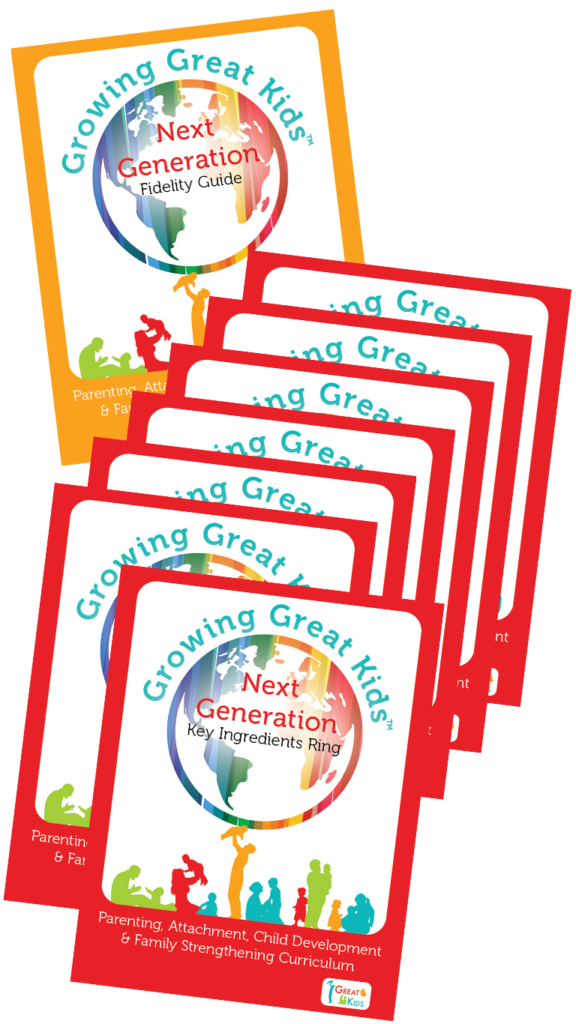It is so exciting that parents are thinking critically and asking good questions. This question is harder to answer than one would expect, but not because of a lack of evidence. It becomes challenging to summarize the abundance of evidence showing the impact of nurturing, empathic, responsive parenting behaviors on self-regulation in children. Because of the holistic nature of the GGK material on parenting, the answer to “Where’s the research on that?” is a large topic to cover. Since the example given references E-Parenting, which is really the heart of the curriculum, starting there seems to make the most sense.
The GGK curriculum is based on Attachment Theory. More than half a century of scientific research was kicked off by the early work of John Bowlby (Bowlby, 1958) whose Theory of Attachment suggested that children come to the world biologically programmed to attach with others because they must in order to survive. His work indicated that the determinant of attachment was care and responsiveness to the child’s needs, specifically during the critical period of development between 0-5 years of age. The theory holds that if a child does not form a secure attachment during this period, they will suffer developmental consequences, including such things as increased aggression.
Scientists have been investigating this theory ever since. The work of Mary Ainsworth (Ainsworth & Bell, 1970), Harry Harlow (Harlow & Zimmermann, 1958), Bruce Perry (Perry & Dobson, 2010), Jay Belsky (Belsky, Jaffee, Sligo, Woodward, & Silva, 2005), Wendy Travis (Travis & Combs-Orme, 2007), and Daniel Siegel (Siegel, 2012), just to name a few, all indicates that healthy child development is connected directly to the quality of that early attachment relationship.
Based on this and other research indicating that the parent-child relationship acts as the prototype for all future social relationships, the focus of the GGK curriculum is to guide program staff in cultivating the development of secure attachment relationships between parents and their children.
Recent studies in the field of Social Neuroscience have gone on to further validate the implications of a child’s early relationship with their caregiver. In his book Social Intelligence: The New Science of Human Relationships, Daniel Goleman (Goleman, 2007) cites a vast amount of recent research that proves valuable in gaining an understanding of why attachment relationships are so critical to the developing brain. He specifically investigates brain architecture down to the cellular and epigenetic changes that occur based on early social-emotional experiences.
As to the specifics of E-parenting and why it results in fewer temper tantrums for example, the science is based on the idea of co-regulation. In her book Ordinary Magic: Resilience in Development, Ann Masten (Masten, 2014) sums it up best as she explains co-regulation. By employing sensitive caregiving, a parent is providing the “external regulatory capacity for the developing child until the child is mature enough to regulate his or her own biological functions, emotion, arousal, stress, and behavior.” This kind of support is believed to play a key role in the development of self-regulation. The GGK E-Parenting Daily Do is designed to provide parents with a step by step process which provides the kind of nurturing responses that help children grow the ability to control their own emotions, ultimately in turn leading to a decrease in behavioral challenges.
Daniel Siegel has a few short (less than 5 minute video clips) that might serve as excellent ways to share with a parent the brain science behind why the E-Parenting strategy is so important. The first one is called Connecting to Calm that explains the idea of connecting with a child in a manner very similar to the E-Parenting process. Here is a link to this video on YouTube. https://youtu.be/aV3hp_eaoiE . The next one is called How Storytelling Connects Both Sides of the Brain and can be accessed with the following link http://www.kidsinthehouse.com/teenager/parenting-teens/talking-with-your-teen/how-storytelling-connects-both-sides-of-the-brain . This second one is even shorter and perhaps a bit more to the point.
This is a start, at least with some of the basics of the research evidence behind many of the parenting skills encouraged in the GGK curriculum. You will find these concepts embedded in many of the specific GGK tools (E-Parenting, Getting in Sync, Ready for Play, Character Builders, Play by Play, 4 Steps to Success, Child Development Activities, and even, indirectly to Brain and Body Builders).
As recently as this month, the American Journal of Public Health contains an article on the relevance of noncognitive skills (social-emotional specifically) in development for both personal and public health outcomes (Jones, Greenburg, & Crowley, 2015). This kind of research begins to explore the unique associations that exist beyond the simple child and family context, and even looks at the pay-offs for society at large.
Thanks for asking the hard questions. A Home Visitor, needs to be able to inspire parents to make what can be difficult changes in parenting style. This requires the kind of ongoing professional development that involves remaining current on the theories and research behind the practice. The materials referenced herein will add some stepping stones in that journey.
References
Ainsworth, M., & Bell, S. M. (1970). Attachment, exploration, and seperation: Illustrated by the behavior of one-year-olds in a strange situation. Child Development, 49-67.
Belsky, J., Jaffee, S. R., Sligo, J., Woodward, L., & Silva, P. A. (2005). Intergenerational transmission of warm-sensitive-stimulating parenting: A prospective study of mothers and fathers or 3 year olds. Child Development, 384-396.
Bowlby, J. (1958). The nature of the childs ties to his mother. International Journal of Psychoanalysis, 350-371.
Goleman, D. (2007). Social Intelligence: The New Science of Human Relationships. Bantam Books.
Harlow, H. F., & Zimmermann, R. R. (1958). The development of affective responsiveness in infant monkeys. Proceedings of the American Philosophical Society, 501-509.
Jones, D. E., Greenburg, M., & Crowley, M. (2015). Early social-emotional functioning and public health: The relationship between kindergarten social competence and future wellness. American Journal of Public Health, 2283-2290.
Masten, A. (2014). Ordinary Magic: Resilience in Development. New York: Guilford Press.
Perry, B., & Dobson, C. (2010). The role of healthy relational interactions in buffering the impact of childhood trauma. In E. Gil, Working with Children to Heal Interpersonal Trauma: The Power of Play. New York: Guilford Press.
Siegel, D. (2012). The Developing Mind: How Relationships and the Brain Interact to Shape Who We Are (second edition). New York: The Guilford Press.
Travis, W. J., & Combs-Orme, T. (2007). Resilient parenting: Overcoming poor parental bonding. . Social Work Research, 135-149.

